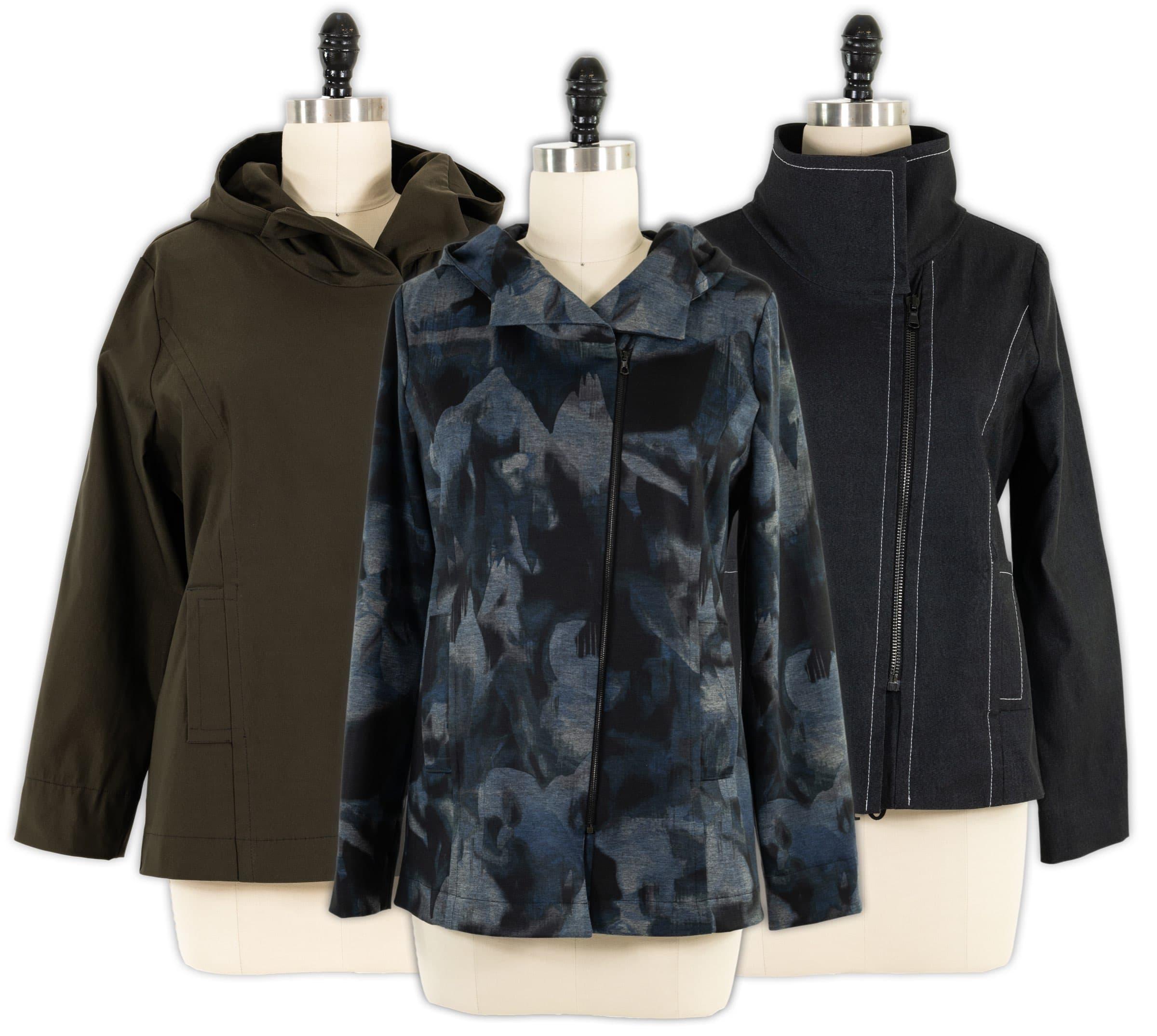

Suggested fabrics
This pattern requires fabric with good stretch and recovery: stretch wovens such as denim, twill, jacket weight tech fabrics with stretch, stretch faux suede or ponte, stable knits such as ponte, light weight scuba, double knits or stable sweater knits. That said, one of our pattern testers used a lighter shirting weight crinkled polyester and the crinkles gave the needed stretch. If you want to use a non-stretch fabric, I’d recommend cutting it larger, or, ideally, making a muslin for the body of the garment in a knit or stretch woven in a jacket weight.For the pattern envelope, I used one of our Ace Collection fabrics in denim blue (sold out), and a printed ponte.







Sewing Tips
- I used 1 ½” hems on everything.
- If your fabric is thick or heavy, consider using a lighter weight fabric for the facings.
- A walking foot is highly recommended for sewing and topstitching
- Make a test with your fabric scraps to determine the optimal topstitching width for your fabric. We used ⅜”
- If you want a more defined topstitching effect, use a topstitching needle and stitch using 2 threads in the upper machine (one thread in the bobbin). Test to determine the optimal stitch length - we used a 4.0 length on the denim version.
- Test your fabric to determine whether to use interfacing and what is the optimal weight for your fabric. One of our pattern testers used a soft ponte and interfaced the upper collar to give it more structure.
- Another pattern tester eliminated the welts, so the pockets are in the seam.
- I sent off to Botani for zippers. 15” for the shorter version and 18” for the longer. Ordered the 2 lengths in with different color teeth and weights in the tape just to have on hand. The quality is excellent and I want to have a small assortment of colors and weights on hand for future projects. Botani makes these to order and the turnaround time was quick, highly recommend as they are on a par with fine RTW. Visit Botani.
- The zipper is enclosed in the seams, so topstitching is optional. If you are using topstitching as a design detail, wait to topstitch the zipper until the collar/hood are sewn in place, then do the final topstitching at the end.
- The left zipper lies on the placket and the right zipper is the edge of the right front.
- After setting the sleeve (I recommend basting and light pressing), try on the jacket to be sure the shoulder seam is placed correctly on your body, and to be sure the ease is even.
Inner finishing tips Finish the outer edges of the facings before inserting the zipper. Bind, serge or clean finish. I added small patch pockets in a lining fabric to the facing. Also note in the photo below to edgestitch along the short edges of the welt, stitching through all layers including the facing - this helps secure the facing flat and in place.
Can I use buttons instead of a zipper? I have not tried this yet, but our wonderful pattern maker makes these suggestions.
To adjust the front for buttons, I think you have 2 choices.
- Add 1" to 1 1/2" to the right front. This will create a bigger extension to cover the left zipper seam.
- Or you can tape the left front placket to the left front to omit the zipper seam. Then just use the overlap that is already part of the pattern. Although for a jacket, it gets a little skimpy at the bottom edge.
- And come to think of it, you can do both these ideas at once. Up to you.



Tips for sewing Ace Fabrics
Our Ace collection fabrics are made especially for ready to wear designers and are perfect for this jacket and similar to those used in some of my own favorite RTW pants and jackets as it has excellent stretch and recovery, and a smooth surface so other garments slide over/under easily, is comfortable to wear, and, is an ideal fiber blend. Mid-weight, (slimming, not thick or heavy), with lengthwise stretch. Important that you cut on the cross grain so the stretch goes around the body.
This letter from a customer regarding sewing with Ace fabrics is helpful.
Good Morning Artbarn Studio, A while ago, I purchased the Ace fabric for 2 pair of pants and a lightweight summery travel jacket (black, navy, sand). I've been struggling with the stitching on the stretch direction, it has been puckering in spite of playing with tension, trying paper, and a walking foot. Nothing that I'm currently doing seems to remedy the problem. Perhaps you have a suggestion on how to sew on the stretch direction and avoid the puckering? I like the fabric a lot and the garments will be a reliable addition to my wardrobe when finished. Thank you for your assistance, RobMarcy’s reply: I’ve done a lot of sewing with the ‘Ace’ fabrics and understand your issue which happens to me too. I use a walking foot, test the stitch length on scraps and finesse the stitching as it happens - smoothing it horizontally to the stitching helps. Then press flat as sewn before pressing the seams open - that helps too. I do have a top of the line Reliable iron which makes a huge difference as the combo of steam and a pressing shoe on the iron smooths things out. I use a clapper for finishing seams, simply resting the clapper on the fabric after pressing - no clapping or pounding, just let the fabric cool as the wood absorbs the heat. Takes a bit more time but worth it. Same thing for pressing top stitching. And VERY important to press every step of the way. Then I live with any ‘imperfections’.





